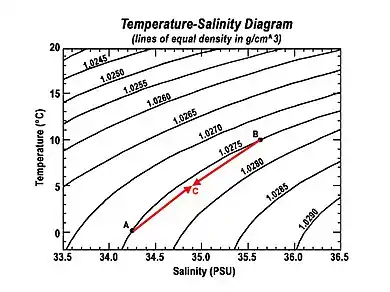Cabbeling
Cabbeling is when two separate water parcels mix to form a third which sinks below both parents. The combined water parcel is denser than the original two water parcels.

The two parent water parcels may have the same density, but they have different properties; for instance, different salinities and temperatures.[1] Seawater almost always gets denser if it gets either slightly colder or slightly saltier.[2] But medium-warm, medium-salty water can be denser than both fresher, colder water and saltier, warmer water; in other words, the equation of state for seawater is monotonic, but non-linear. See diagram.
Cabbeling may also occur in fresh water, since pure water is densest at about 4 °C (39 °F). A mixture of 1 °C water and 6 °C water, for instance, might have a temperature of 4 °C, making it denser than either parent. Ice is also less dense than water, so although ice floats in warm water, meltwater sinks in warm water.
The densification of the new mixed water parcel is a result of a slight contraction upon mixing; a decrease in volume of the combined water parcel.[3] A new water parcel that has the same mass, but is lower in volume, will be denser. Denser water sinks or downwells in the otherwise neutral surface of the water body, where the two initial water parcels originated.[4]
History of term
The importance of this process in oceanography was first pointed out [5] by Witte, in a 1902 publication (Witte, E. (1902). "Zur Theorie der Stromkabbelungen" (PDF). Gaea, Köln.).
The German origin of the term has caused some etymological confusion and disagreements as to the correct spelling of the term;[6] for details, see the Wiktionary entry on cabelling. Oceanographers generally follow Stommel[7] and refer to the process as "cabbeling".
High-latitude cabbeling
Cabbeling may occur in high incidence in high latitude waters. Polar region waters are a place where cold and fresh water melting from sea ice meets warmer, saltier water. Ocean currents are responsible for bringing this warmer, saltier water to higher latitudes, especially on the eastern shores of Northern Hemisphere continents, and on the western shores of Southern Hemisphere continents. The phenomenon of cabbeling has been particularly noted in the Weddell Sea[8] and the Greenland Sea.[9]
References
- Beer, Tom (1997). Environmental oceanography. Boca Raton: CRC Press. p. 123. ISBN 0-8493-8425-7, Section 5.4.3 Cabbeling.
- "Water Density". Archived from the original on 2016-02-12. Retrieved 2016-01-25.
- AMS glossary Archived 2012-03-30 at the Wayback Machine,.
- "AGU: Advanced Search". AGU Journals.
- Theodore D. Foster (1972). "An Analysis of the Cabbeling Instability in Sea Water". Journal of Physical Oceanography. 2 (3): 296. Bibcode:1972JPO.....2..294F. doi:10.1175/1520-0485(1972)002<0294:AAOTCI>2.0.CO;2.
Witte (1902) was evidently the first person to point out the possible importance of this process in the ocean.
- Foster, T. D. (1972). "An Analysis of Cabbeling Instability in Sea Water". Journal of Physical Oceanography. 2 (3): 294–301. Bibcode:1972JPO.....2..294F. doi:10.1175/1520-0485(1972)002<0294:AAOTCI>2.0.CO;2.
Witte thought that the process would be so effective that the sinking would give rise to a rippled or choppy appearance of the sea surface, which in German nautical terminology has been designated "Kabbelung". There is a not very common English cognate "cobbeling" (Webster's Second New International Dictionary) for this word, but the term does not seem to have been generally accepted by oceanographers. There appears to be a great diversity of opinion about the correct spelling of the English word for this mixing process partly, perhaps, due to different opinions concerning the etymology of the word. One opinion is that the word should be spelled "caballing" meaning "to unite in an intrigue" since the two components conspire to form a more dense mixture. Another opinion is that "Kabbelung" should be anglicized to "cabbeling" and can be used to designate the mixing process itself rather than the appearance of a choppy sea surface which was evidently Witte's intention. Rather than introduce a new term we shall follow Stommel (1960, p.31) and refer to the process as "cabbeling".
- Stommel, H. (1960). The Gulf Stream. University of California Press. p. 31.
- Cabbeling in the Weddell Sea paper,.
- Cabbeling in the Greenland Basin paper,.